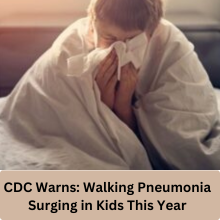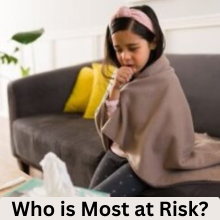
Walking pneumonia is making headlines, especially as the CDC reports a significant rise in cases among children this year. If your child has been coughing persistently, it might be time to pay attention. Let’s break down what walking pneumonia is, why it’s on the rise, and how to keep your little ones safe.
What is Walking Pneumonia?
Walking pneumonia, often caused by the bacteria Mycoplasma pneumoniae, is a milder form of pneumonia that can still lead to serious health issues. The term “walking” refers to the fact that individuals can often go about their daily lives, albeit feeling unwell. Symptoms generally start off mild, making it hard to diagnose early.
How is it Different from Regular Pneumonia?
While typical pneumonia can hit hard and fast, walking pneumonia usually develops gradually. It’s less severe, but that doesn’t mean it should be ignored.
The Rise in Cases: What’s Happening?
Current Statistics
The CDC has reported that cases of Mycoplasma pneumoniae among children ages 2 to 4 jumped from 1% in April to 7.2% by October. That’s a staggering sevenfold increase! Similarly, older children showed an increase from 3.6% to 7.4%.
Why Are Cases Surging?
Experts believe three main factors contribute to this uptick:
- Post-Pandemic Resurgence: Many respiratory illnesses plummeted during the COVID-19 pandemic, leading to a backlog of infections that are now surfacing.
- Cyclical Nature of Infections: Infections like Mycoplasma pneumoniae tend to follow cycles, with spikes occurring every few years as immunity wanes in the population.
- Improved Testing: Advances in diagnostic tools have made it easier for doctors to identify Mycoplasma pneumoniae, leading to more confirmed cases.
Symptoms to Watch For
Recognizing the symptoms early can make a big difference in treatment.Here are the key signs:
Initial Symptoms
- Dry Cough: Often starts mild and worsens over two to three weeks.
- Headache: This can be a common early sign.
- Fever and Chills: These might not be severe but can indicate an underlying issue.
Progressing Symptoms
If the infection worsens, symptoms can escalate to:
- Phlegmy Cough: This might develop as the infection progresses.
- Difficulty Breathing: This is a sign that the infection has become more serious.
Diagnosis and Treatment
How is Walking Pneumonia Diagnosed?
Diagnosing walking pneumonia can be tricky. Unlike typical bacterial infections, Mycoplasma pneumoniae doesn’t grow in standard lab tests. However, new diagnostic tests are helping to identify it more accurately and quickly.
Treatment Options
The first line of defense for many bacterial infections, such as amoxicillin, won’t work against Mycoplasma pneumoniae. Instead, doctors often prescribe:
- Azithromycin: This antibiotic is usually effective.
- Supportive Care: Rest, hydration, and over-the-counter medications can help manage symptoms.
Who is Most at Risk?
Walking pneumonia primarily affects school-aged children and young adults, but this year, preschoolers are seeing a notable rise in cases. Crowded settings like schools and daycare centers are common hotspots for spreading the infection.
Also read: Kelsea Ballerini Hints at Marriage Plans with Chase Stokes
Preventative Measures for Parents
Keeping Kids Healthy
As a parent, you can take steps to minimize the risk:
- Encourage Hand Hygiene: Teach kids the importance of washing hands frequently.
- Promote Vaccination: Stay updated on flu and other vaccinations that can help protect against respiratory infections.
- Limit Exposure: Especially during peak illness seasons, try to keep your child away from crowded places.
When to Seek Medical Attention
If your child has a persistent cough that lasts more than three weeks or shows signs of breathing difficulty, it’s time to consult a doctor. Early intervention can prevent complications.
What to Expect During Recovery
Recovery Timeline
Most children will recover without any need for hospitalization. The recovery period can vary, but symptoms generally start to improve within a couple of weeks if treated appropriately.
Post-Recovery Considerations
Even after symptoms subside, children may need to avoid strenuous activities for a short time to ensure full recovery.
Conclusion
Walking pneumonia is on the rise among children, and it’s crucial for parents to be informed about its symptoms and treatment options. With proper awareness and timely intervention, most kids can recover fully and bounce back to their usual energetic selves.
Also read: Shocking Twist: Menendez Brothers’ Uncle Fights for Justice
FAQs
Is walking pneumonia contagious?
Yes, it spreads through respiratory droplets, making it contagious in crowded settings.
Can walking pneumonia lead to more severe illness?
While many recover without treatment, it can exacerbate conditions like asthma and, in rare cases, lead to more serious complications.
How long does walking pneumonia last?
Symptoms can persist for several weeks, but most children improve within 1-2 weeks with appropriate treatment.
Are antibiotics always necessary?
Not always. Many mild cases resolve without antibiotics, but it’s essential to consult a doctor for proper assessment.
How can I differentiate between walking pneumonia and other respiratory illnesses?
The gradual onset of symptoms and a dry cough are key indicators. Always consult a healthcare provider for a proper diagnosis.
By staying informed and vigilant, parents can navigate this challenging season more effectively. Keep your little ones healthy and happy!

